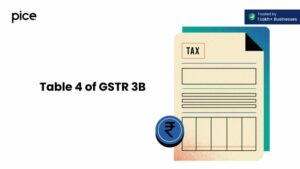GST Rate on Tobacco Products and Cigarettes
- 20 Sep 24
- 9 mins

GST Rate on Tobacco Products and Cigarettes
Key Takeaways
- Tobacco products are taxed at a high GST rate of 28% plus an additional compensation cess.
- GST aims to reduce the affordability of tobacco products by significantly increasing their prices.
- Different tobacco products, including cigarettes and smokeless tobacco, have specific GST and cess rates.
- GST implementation has impacted the tobacco industry's revenue and consumer pricing strategies.
- The government uses high taxation on tobacco to curb consumption and address public health concerns.
The implementation of GST in India has significantly affected the tobacco industry, altering the tax landscape for various tobacco products, including cigarettes, pan, gutkha, and other forms of smokeless tobacco.
GST Rate for Tobacco
Tobacco products are subject to one of the highest GST rates in India, reflecting the government's efforts to curb tobacco consumption due to its health impacts. The standard GST rate for tobacco products is set at 28%, with additional levies such as the GST cess rate. This high tax rate aims to reduce the affordability of tobacco products, thus controlling their demand, especially in a country recognized as one of the largest consumers of tobacco worldwide.
However, the implementation of GST has also brought economic costs, impacting the tobacco supply chain and the revenue from tobacco products. Tobacco taxation is complex, involving multiple components such as value-added tax revenue, excise duty, and compensation cess. These taxes have a direct effect on the retail price and real prices of tobacco products, influencing their average consumption and demand elasticity.
GST Cess for Tobacco Products
In addition to the high GST rate, a compensation cess is imposed on tobacco products to offset the revenue shortfalls caused by the transition to the GST regime. This cess is part of the government's strategy to address the national calamity contingent duty that arises due to tobacco-related diseases and public health concerns.
GST Rate and Cess for Pan, Gutkha, Chewing Tobacco, and Tobacco Products
Pan, gutkha, and other smokeless tobacco products are subject to a statutory GST rate of 28%, plus a significant GST cess. The additional cess further increases the overall tax burden on these products, reflecting the government's public policy to discourage their use. Smokeless tobacco taxation aims to address the affordability of tobacco products and reduce the health risks associated with their consumption. For instance, the demand for tobacco products like pan and gutkha has shown sensitivity to tax increases, as reflected in studies on price elasticity and the manual on tobacco tax.
💡 If you want to pay your GST with Credit Card, then download Pice Business Payment App. Pice is the one stop app for all paying all your business expenses.
GST Rate and Cess for Cigarettes
Cigarettes are taxed at the highest rate under the GST regime, with a GST rate of 28% coupled with a high cess based on the length of the cigarette. Filter cigarettes and cigarettes of tobacco substitutes fall into this category, with the cess calculated per unit length. The tax burden on cigarettes also includes excise duty and other forms of indirect taxation. The cumulative effect of these taxes impacts the price of cigarettes and can potentially alter trends in affordability and consumption patterns. This high taxation is part of efforts to control the tobacco epidemic and limit the harm from tobacco.
GST Rate and Cess for Other Tobacco Products
Other tobacco products such as cigarillos of tobacco substitutes, tobacco extracts, and hookah tobacco are also taxed at 28% GST along with a compensation cess. The GST on tobacco products aims to reduce tobacco consumption by making these products more expensive. The National Calamity Contingent Duty further raises the tax burden on these products, aligning with the government's goal to address the potential impact of tobacco use on public health and revenue.
HSN Code for Tobacco

The Harmonized System of Nomenclature (HSN) code is used for classifying tobacco products for taxation purposes. Each type of tobacco product, including cigarettes, chewing tobacco, and smokeless tobacco products, has a specific HSN code that determines its tax rate under GST. The proper classification is crucial for calculating the correct GST cess rate and ensuring compliance with the tobacco tax policy.
How to Calculate GST on Tobacco?
Calculating GST on tobacco involves applying the statutory GST rate of 28% to the product's base price, followed by the additional GST cess. For example, the GST on cigarettes includes the base price, the 28% GST rate, and a cess calculated based on the length of the cigarette. Tobacco manufacturing units must also consider other taxes such as excise duty and indirect taxation, which contribute to the overall tax liability. Businesses in the tobacco industry must stay informed about tax rates and use proper methods data to calculate their GST liabilities accurately.
Which Tobacco Products Remain Unaffected by the New Policy?
Despite the extensive GST implementation, some tobacco products may remain relatively untouched by the new policy due to the specific nature of their market or production. For instance, products in the informal tobacco sector, such as certain forms of traditional or unprocessed tobacco, may not be as heavily taxed as mainstream tobacco products. This distinction creates an aggregate state-wise impact, as informal products might evade the full tax burden, affecting the overall revenue from tobacco taxation.
Impact of Capping the GST Compensation Rate for Certain Tobacco Products
The capping of the GST compensation rate for certain tobacco products has implications for both the tobacco industry and the government. While the cap aims to balance revenue generation with public health objectives, it also has a national level impact by influencing the prices of tobacco products. The cap can affect the affordability of tobacco products, potentially leading to changes in consumer behavior and tobacco consumption. For instance, a cap on the GST cess rate could lead to a quick price adjustment in the retail market, affecting the average consumption patterns and the demand elasticity for tobacco products.
The government also considers the broader economic context, including the crores of revenue generated from the tobacco industry. Tobacco users, particularly in middle-income countries, are sensitive to price changes, as indicated by the own-price elasticity of demand. Hence, policymakers must weigh the potential health benefits of reduced tobacco use against the revenue shortfalls that might arise from capping the GST rate and cess.
In conclusion, the impact of GST on tobacco products is multifaceted, encompassing public policy, economic costs, and public health considerations. While high GST rates and compensation cess aim to reduce tobacco consumption and its associated harms, they also present challenges for the tobacco industry in terms of compliance, revenue, and pricing strategies. Understanding these dynamics is crucial for stakeholders, including tobacco manufacturers, policymakers, and public health advocates, to navigate the complex landscape of tobacco taxation under the GST regime.
 By
By 

















